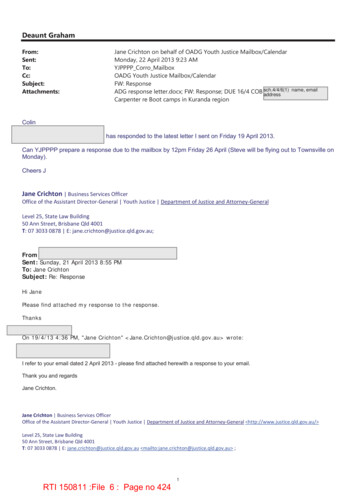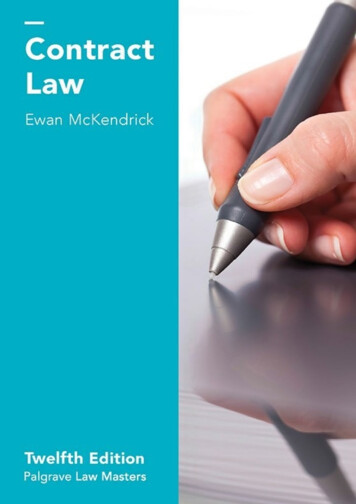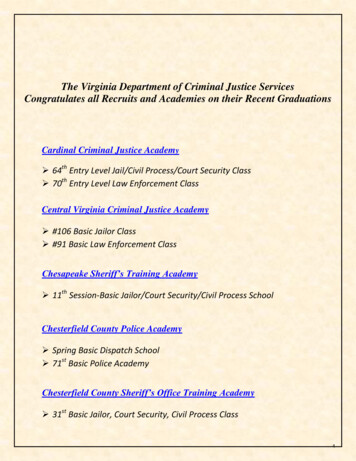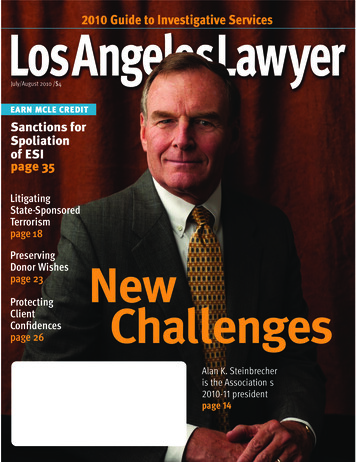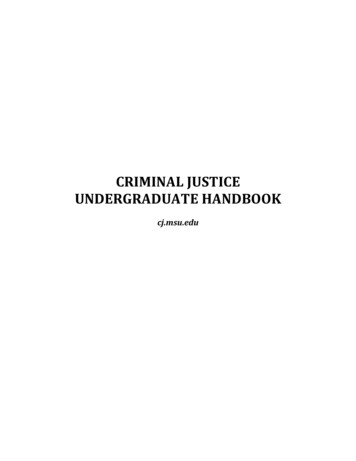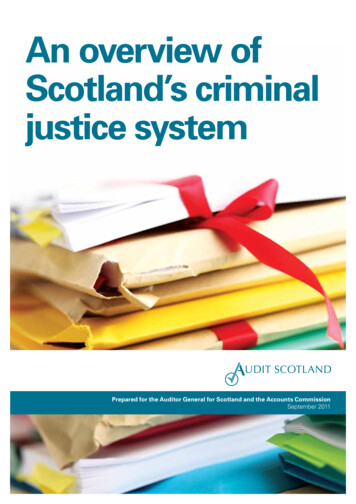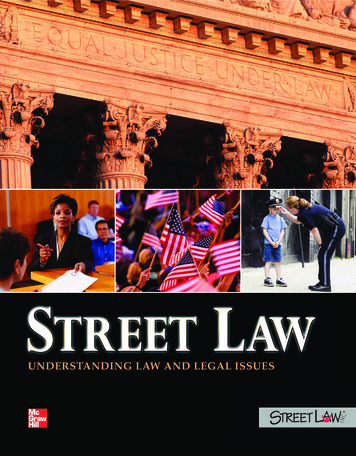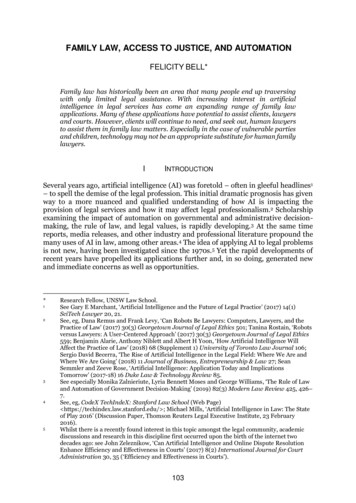
Transcription
FAMILY LAW, ACCESS TO JUSTICE, AND AUTOMATIONFELICITY BELL*Family law has historically been an area that many people end up traversingwith only limited legal assistance. With increasing interest in artificialintelligence in legal services has come an expanding range of family lawapplications. Many of these applications have potential to assist clients, lawyersand courts. However, clients will continue to need, and seek out, human lawyersto assist them in family law matters. Especially in the case of vulnerable partiesand children, technology may not be an appropriate substitute for human familylawyers.IINTRODUCTIONSeveral years ago, artificial intelligence (AI) was foretold – often in gleeful headlines1– to spell the demise of the legal profession. This initial dramatic prognosis has givenway to a more nuanced and qualified understanding of how AI is impacting theprovision of legal services and how it may affect legal professionalism.2 Scholarshipexamining the impact of automation on governmental and administrative decisionmaking, the rule of law, and legal values, is rapidly developing. 3 At the same timereports, media releases, and other industry and professional literature propound themany uses of AI in law, among other areas.4 The idea of applying AI to legal problemsis not new, having been investigated since the 1970s. 5 Yet the rapid developments ofrecent years have propelled its applications further and, in so doing, generated newand immediate concerns as well as opportunities.*12345Research Fellow, UNSW Law School.See Gary E Marchant, ‘Artificial Intelligence and the Future of Legal Practice’ (2017) 14(1)SciTech Lawyer 20, 21.See, eg, Dana Remus and Frank Levy, ‘Can Robots Be Lawyers: Computers, Lawyers, and thePractice of Law’ (2017) 30(3) Georgetown Journal of Legal Ethics 501; Tanina Rostain, ‘Robotsversus Lawyers: A User-Centered Approach’ (2017) 30(3) Georgetown Journal of Legal Ethics559; Benjamin Alarie, Anthony Niblett and Albert H Yoon, ‘How Artificial Intelligence WillAffect the Practice of Law’ (2018) 68 (Supplement 1) University of Toronto Law Journal 106;Sergio David Becerra, ‘The Rise of Artificial Intelligence in the Legal Field: Where We Are andWhere We Are Going’ (2018) 11 Journal of Business, Entrepreneurship & Law 27; SeanSemmler and Zeeve Rose, ‘Artificial Intelligence: Application Today and ImplicationsTomorrow’ (2017-18) 16 Duke Law & Technology Review 85.See especially Monika Zalnieriute, Lyria Bennett Moses and George Williams, ‘The Rule of Lawand Automation of Government Decision‐Making’ (2019) 82(3) Modern Law Review 425, 426–7.See, eg, CodeX TechIndeX: Stanford Law School (Web Page) https://techindex.law.stanford.edu/ ; Michael Mills, ‘Artificial Intelligence in Law: The Stateof Play 2016’ (Discussion Paper, Thomson Reuters Legal Executive Institute, 23 February2016).Whilst there is a recently found interest in this topic amongst the legal community, academicdiscussions and research in this discipline first occurred upon the birth of the internet twodecades ago: see John Zeleznikow, ‘Can Artificial Intelligence and Online Dispute ResolutionEnhance Efficiency and Effectiveness in Courts’ (2017) 8(2) International Journal for CourtAdministration 30, 35 (‘Efficiency and Effectiveness in Courts’).103
104MACQUARIE LAW JOURNAL[Vol 19In its loosest sense, artificial intelligence refers to software processes which can carryout tasks that, if performed by a person, would be considered evidence of intelligence.6Distinction is made between ‘general’ AI and ‘narrow’ AI. In precisely defined tasks,such as playing the ancient board game of Go,7 narrow AI processes can outperformhumans. However, the AI ‘robolawyer’8 with the broad range of skills which humanspossess, is still some time off.9 As discussed in Part II, ‘AI’ is a loose term to describe acollection of tools and functions. In this article it is used to denote a range of differentautomated systems and processes which have in common their capacity to mimicaspects of legal services, in this case with particular reference to family law.In relation to the justice system, Professor Tania Sourdin has categorised technologicaleffects as coalescing around three impacts: supporting those involved in the system;replacing elements of the system that were previously conducted by humans; anddisrupting or fundamentally transforming the system.10 She notes that, to date, mostreforms have involved the first two categories (supporting and supplementing). 11 Wecan differentiate, for example, between supporting a decision-maker to make theirdecision (such as by guiding them through a series of steps) as opposed to actuallyautomating the decision process.12 However, the expansion of AI into administrativedecision-making,13 and the growth in online dispute resolution options – includingunder the auspices of the court system – suggests that the third category is developingquickly.Meanwhile, some North American scholars have suggested that lawyers practising infamily law will continue to enjoy greater job security when compared to theircolleagues in other areas of law, given the importance of human interaction for familylaw clients.14 Yet the imperatives of financial strain and the difficulty of obtaining legalaid already raise access to justice concerns and compel many in the direction of lessthan full legal representation, whether they are partially represented, self-representedand/or accessing other kinds of legal information, advice and support systems. 156789101112131415Jerry Kaplan, Artificial Intelligence: What Everyone Needs to Know (Oxford University Press,2016) 1.See, eg, AlphaGo Home (Web Page) https://deepmind.com/research/alphago/ .Jason Koebler, ‘Rise of the Robolawyers: How Legal Representation Could Come to ResembleTurboTax’ (April 2017) The Atlantic 04/rise-of-the-robolawyers/517794/ .Though some predict that this will be achieved by 2050: Seth D Baum, Ben Goertzel and Ted GGoertzel, ‘How Long Until Human-Level AI? Results from an Expert Assessment’ (2011) 78(1)Technological Forecasting & Social Change 185.Tania Sourdin, ‘Justice and Technological Innovation’ (2015) 25(2) Journal of JudicialAdministration 96, 96 (‘Justice and Technological Innovation’).Ibid.Zeleznikow, ‘Efficiency and Effectiveness in Courts’ (n 5) 37.See, eg, Zalnieriute, Bennett Moses and Williams (n 3); Dominique Hogan-Doran, ‘ComputerSays “No”: Automation, Algorithms and Artificial Intelligence in Government Decision-Making’(2017) 13(3) The Judicial Review 345.Noel Semple, ‘Personal Plight Legal Practice and Tomorrow’s Lawyers’ (2014) 39(1) Journal ofthe Legal Profession 25 (‘Personal Plight Legal Practice’); Samuel V SchoonmakerIV, ‘Withstanding Disruptive Innovation: How Attorneys Will Adapt and Survive ImpendingChallenges from Automation and Nontraditional Legal Services Providers’ (2017) 51(2-3)Family Law Quarterly 133.John Dewar, Barry W Smith and Cate Banks, ‘Litigants in Person in the Family Court ofAustralia’ (Research Report No 20, Family Court of Australia, 2000) 16, use the term ‘partiallyrepresented’ to denote litigants who may have lawyers come and go. The authors observe thatalthough a person may appear in court without legal representation does not mean that the
2019]FAMILY LAW, ACCESS TO JUSTICE AND AUTOMATION105Access to justice in family law matters has been identified as a serious problem inAustralia (and indeed in other common law jurisdictions, such as Canada and Englandand Wales).16 This is a key reason why developments in the categories described bySourdin have already impacted and have the potential to further impact the way thatfamily law legal services are delivered.Automated systems hold out many possibilities for improving information provisionand supporting decision-makers; for replacing some elements of legal work; and even,as Sourdin notes, ‘where predictive analytics may reshape the adjudicative role’. 17Many of its applications can be of use to family law clients and to family lawyersthemselves. At the same time, it is important to be wary of seeing automated systemsas too ready a solution in the face of constraints on the family law system and whatProfessor John Dewar termed ‘the normal chaos of family law’.18Part III discusses some of the reasons that family lawyers may be seen as necessary infamily law disputes but also constraints on access to justice and problems with thefamily law system. Part IV describes some examples of automation in family law, whilePart V examines specific issues associated with increasing use of automated systems,and Part VI concludes.II‘AI’, ‘LEGALTECH’ AND OTHER UMBRELLA TERMSArtificial intelligence is an umbrella term which may encapsulate many differentmethods and lacks an agreed or consensus meaning.19 As someone joked on Twitter,‘If it is written in Python, it’s probably machine learning. If it is written in PowerPoint,it’s probably AI’.20 AI might also be referred to generically as automated systems. 21Despite the reference to ‘intelligence’, ‘[a]n AI system is not really “reasoning” or“thinking” but is following a set of pre-programmed or computational steps ormathematically analysing a huge amount of data to infer a probability’.2216171819202122person has not accessed some form of legal advice or information beforehand. Differingdefinitions of ‘self-represented’ exacerbate problems for evidence-based decision-making: seeElizabeth Richardson and Tania Sourdin, ‘Mind the Gap: Making Evidence-Based Decisionsabout Self-Represented Litigants’ (2013) 22(4) Journal of Judicial Administration 191, 194–95.See, eg, Michael Saini, Rachel Birnbaum and Nicholas Bala, ‘Access to Justice in Ontario’sFamily Courts: The Parents’ Perspective’ (2016) 37(1) Windsor Review of Legal and SocialIssues 1, 1-2 n 2; Asher Flynn and Jacqueline Hodgson (eds), Access to Justice and Legal Aid:Comparative Perspectives on Unmet Legal Need (Hart Publishing, 2019); John Eekelaar andMavis Maclean, Family Justice: The Work of Family Judges in Uncertain Times (HartPublishing, 2013) (‘Family Justice’).Note that Sourdin discusses some of the many issues around technology supplanting thejudicial role but this is not the focus here: Tania Sourdin, ‘Judge v Robot: Artificial Intelligenceand Judicial Decision-Making’ (2018) 41(4) University of New South Wales Law Journal 1114,1117 (‘Judge v Robot’).John Dewar, ‘The Normal Chaos of Family Law’ (1998) 61(4) The Modern Law Review 467.Ellen Broad, Made by Humans: The AI Condition (Melbourne University Press, 2018) xix.@matvelloso (Mat Velloso) (Twitter, 22 November 2018, 5:25PM AEST) 2282885?lang en ; Python is aprogramming language: Welcome to Python.org (Web Page) https://www.python.org/ .Broad (n 19) xx.Michael Legg and Felicity Bell, ‘Artificial Intelligence and the Legal Profession: A Primer’ (LawSociety of NSW and UNSW Law, 2019) 2, available at FLIP Stream (Web Page) intelligence-and-legal-professionprimer .
106MACQUARIE LAW JOURNAL[Vol 19AI has developed considerably since its early iterations, though progress has not beenlinear but rather marked by a series of cycles – rapid development and generousfunding punctuated by ‘AI winters’.23 The current surge in interest has been fuelled bythe greatly increased processing power (at considerably less relative cost) ofcomputers, including personal computers and devices, and the massively increasedvolumes of electronic information or data that are available.The history of AI and law, a discipline established decades ago, is illustrative. Fromthis period onwards academics investigated ‘expert systems’, using decision trees, tosolve legal problems.24 These types of system are representative of existing knowledgeand are pre-programmed with logical rules and definitions. They may also employmathematical formulae and weightings of different variables. Their outputs might bean assessment of a legal situation, or the automatic completion of a form.25During the 1990s, there was interest in the AI and law community not only in expertsystems based on explicit rules but in ‘case based reasoning systems’, which attemptedto derive those rules from an existing body of case law.26 The limitations of theseapproaches led to investigation of neural nets as a means of overcoming them. Neuralnets are systems structured in a way that mimics the (projected) architecture of thehuman brain as a network of interconnected nodes. Exploration of the possibilities ofneural nets has occurred, as explained in Part IV, in the development of systems forfamily law disputes.27Professor Kevin Ashley has noted that ‘legal expert systems are still widespread inuse’,28 and some of their applications are discussed below. However, Ashley considersthat they will not revolutionise the delivery of legal services.29 Rather, it is advances incognitive computing, or machine learning, that are galvanising interest, and massiveinvestment, today.30 Neural networks are one subset of methods which fall under theumbrella of ‘machine learning’. In particular, ‘deep’ neural networks (with multiple‘hidden’ layers), used for ‘deep learning’, are behind many publicised AIdevelopments.31Sometimes referred to as ‘data-driven systems’, machine learning programs ‘inferformal relations from unstructured data’.32 Rather than being pre-programmed withrules, the program itself identifies patterns and correlations in training data andcreates a mathematical or statistical model which is then applied to new data.23242526272829303132Toby Walsh, It’s Alive! Artificial Intelligence from the Logic Piano to Killer Robots (La TrobeUniversity Press and Black Inc, 2017) 49–50.Kevin D Ashley, Artificial Intelligence and Legal Analytics: New Tools for Law Practice in theDigital Age (Cambridge University Press, 2017) 8–9.Ibid 9.See Michael Aikenhead, ‘The Uses and Abuses of Neural Networks in Law’ (1996) 12 SantaClara Computer & High Technology Law Journal 31, 44–46 nn 43–48.John Zeleznikow and Andrew Stranieri, ‘The Split-Up System: Integrating Neural NetworksReasoning in the Legal Domain’ (Conference Paper, International Conference on ArtificialIntelligence and Law, 21–24 May 1995) 185; John Zeleznikow, ‘The Split-Up Project: Induction,Context and Knowledge Discovery in Law’ (2004) 3(2) Law, Probability and Risk 147.Ashley (n 24) 10.Ibid.Walsh (n 23).See, eg, Anthony Elliott and Julie Hare, ‘The Revolution Will Not Be Televised – The AIChallenge’, The Australian (Sydney, 18 April 2019) 27.Rostain (n 2) 561.
2019]FAMILY LAW, ACCESS TO JUSTICE AND AUTOMATION107Supervised machine learning refers to providing the program with labelled trainingdata – in other words, indicating the outputs which are sought. An image recognitionprogram could be trained with photos already labelled as to what they depict (or moreprecisely, what a human has determined they depict),33 for example, an apple or anorange. The goal then might be for the program to correctly classify a new image asone or the other, or as something else. Using all the data available – in this case, everypixel of every image – the program uses inductive reasoning to deduce the ‘rules’ whichmatch the data to the correct labels. The program can then itself ‘learn’ therelationships between inputs and outputs. Importantly, it can continue to adjust itsmodel as it is provided with new data. Unsupervised learning, on the other hand, iswhere the software is provided with data (such as many images of fruit) and left toidentify patterns on its own.34 Supervised learning is more common in legalapplications.35It would be a mistake, however, to think that humans do not have control or input overhow systems are created. Rather, as David Lehr and Professor Paul Ohm explain, atevery step in what may be a complex process, human input is required.36 The questionto be addressed, the data, the choice of algorithm or ‘the software code that exploresthe relationships between the input information and the answers’, 37 and weightingmechanisms, are all crucially important factors. Essentially, the programs are doingstatistical analysis, but with the potential for millions of data points to be input, andbillions of relationships modelled – in other words on a much more complex scale.An application of machine learning which is important to legal applications is naturallanguage processing (NLP), ‘a collective term referring to automatic computationalprocessing of human languages’.38 This includes both algorithms that take humanproduced text as input, and algorithms that produce natural looking text as outputs’.39The natural language of humans is complex because it is contextual – sentence orderis important and words have multiple meanings.Developments in machine learning and NLP have generated renewed interest in thelegal applications of AI,40 and in ‘LegalTech’ (technology and software with legalapplications) more generally. It can be difficult to discern technology that makes useof AI (even broadly defined) and that which does not. The latter might include moreconventional software for billing or document storage, for example. As explainedabove, an expansive definition of AI is adopted here to refer to automated systems3334353637383940For the difficulties that this may generate: see Broad (n 19).John Markoff, ‘How Many Computers to Identify a Cat? 16,000’, New York Times (online, 25June 2012) ing.html .David Lehr and Paul Ohm, ‘Playing with the Data: What Legal Scholars Should Learn aboutMachine Learning’ (2017) 51(2) University of California, Davis Law Review 653.Ibid 673.Warren E Agin, ‘A Simple Guide to Machine Learning’ (2017) 14(1) SciTech Lawyer 5.Jason Brownlee, ‘What is Natural Language Processing?’, Machine Learning Mastery, (WebPage, 22 September 2017) eprocessing/ .Yoav Goldberg, Neural Network Methods in Natural Language Processing (Morgan &Claypool Publishers, 2017) xvii.Michael Mills and Julian Uebergang, ‘Artificial Intelligence in Law: An Overview’ [2017] (139)Precedent 35.
108MACQUARIE LAW JOURNAL[Vol 19which, unlike more general ‘LegalTech’, are capable of substituting for lawyers orelements of legal work in relation to complex processes.Supervised machine learning is very useful in certain legal contexts – for example,where a huge number of documents must be reviewed in discovery. Provided that thedocuments are electronically readable (or can be converted to a readable format), thesoftware can review and learn to classify them as either discoverable, or not. 41 OtherAI legal tools may use some form of simple expert system where an internet bot, orquestion and answer tree, guides the user through a series of steps.By blending expert systems with machine learning, it is also possible to design toolswhich also learn from the examples with which they are provided, increasing theirsophistication. There are many such programs available, particularly in the UnitedStates.42 The Law Society of England and Wales predicts that as these types of systembecome ever more sophisticated and fluent in natural language processing, they willincreasingly be manned ‘by robots with the ability to test queries against a vastdatabase of past information in seconds – as IBM Watson demonstrates formedicine’.43 Typically, the more they are used, the more such programs learn, andtherefore they continue to improve as they address more queries.44Substantial claims have been made generally about the capacity of legal AI orautomated systems (and indeed, technology in general) to improve access to justice.45This may occur through clients being able to do their legal work themselves; throughclients doing some elements of their own legal work (unbundling);46 or throughlawyers using technology to themselves work more efficiently and pass costs savingson to their clients. The US Legal Services Corporation, in its ‘vision’ for improvingaccess to justice through the use of technology, described a strategy with fivecomponents, including the development of expert systems ‘to assist lawyers and otherservices providers’.4741424344454647Thomas Davey and Michael Legg, ‘Machine Learning Disrupts Discovery’ [2017] (32) LawSociety Journal 82.Stanford University, CodeX Techindex, ‘Document Automation’, ry 2 .Tara Chittenden, ‘Capturing Technological Innovation in Legal Services’ (Research Report, TheLaw Society of England and Wales, 25 January 2017) 12.See, eg, Christopher Knaus, ‘NDIA denies Cate Blanchett-voiced 'Nadia' virtual assistant is indoubt’, The Guardian (online, 22 September 2017) ant-is-in-doubt .See generally Lois R Lupica, Tobias A Franklin and Sage M Friedman, ‘The Apps for JusticeProject: Employing Design Thinking to Narrow the Access to Justice Gap’ (2017) 44(5)Fordham Urban Law Journal 1363; Jessica Frank, ‘A2J Author, Legal Aid Organizations, andCourts: Bridging the Civil Justice Gap Using Document Assembly’ (2017) 39(2) Western NewEngland Law Review 251; David Luban, ‘Optimism, Skepticism and Access to Justice’ (2016)3(3) Texas A&M Law Review 495, 502.Sourdin, ‘Judge v Robot’ (n 17) 1118; Michael Legg and John Corker, ‘Unbundling for Access toJustice and for Commercial Law’, Presentation to Future of Law and Innovation in theProfession (FLIP) Conference, Sydney, 14 September 2018.LSC: Legal Services Corporation, Report of the Summit on the Use of Technology to ExpandAccess to Justice (Report, December 2013) 2.
2019]FAMILY LAW, ACCESS TO JUSTICE AND AUTOMATIONIII109FAMILY LAWYERINGFamily law is often seen as necessitating skills which are not strictly technical or legal,and indeed might fall into the category of ‘life skills’ which are attained throughexperience rather than formal training. The idea that family law is qualitativelydifferent to other areas of practice has been largely embraced by family lawyers,possibly in part as a reaction to the traditional view of family law as a ‘low status’branch of legal practice.48 The characterisation of family law as a separate, specialistarea of law is also sometimes connected to the espousal of non-litigiousness bylawyers. Family law involves clients who are likely to be traversing one of the mostdifficult periods in their lives (and hence, not be in an optimal position to makeimportant decisions) and, importantly, where the interests of vulnerable non-parties,namely children, often require consideration. One former judge has described familylaw as involving value judgments about deeply personal aspects of life.49 All thesefactors, which are explicated in greater detail below, indicate some of the complexitiesinvolved in automating family law.Nevertheless, non-lawyer or ‘self-help’ options are not at all new to family law. Forexample, with the introduction of ‘no-fault’ divorce in many states of the United Statesin the 1970s, divorce ‘kits’ and self-help books proliferated.50 In the 1990s, as well asprinted materials, software (available for purchase on CD-ROM, for example) could beused to simplify the completion of forms.51 Information about family law has beenaround on the internet for a long time, and has already produced a cultural changetoward self-help.52 Generally, people are more likely to seek information on theinternet, including in areas which would once have been considered to requireprofessional advice. 53 One Canadian study suggested that this is a factor driving selfrepresentation, more so than a general dislike or mistrust of lawyers.54The arguments that were made about these kinds of materials at the time areessentially the same as those raised about the considerably more sophisticated optionsnow available. These concern whether they might violate prohibitions on unauthorisedpractice of law, by crossing over from being mere provision of legal information toconstituting legal advice.55 More generally, there is a debate as to whether providing4849505152535455Martha Minow, ‘“Forming Underneath Everything That Grows”: Toward a History of FamilyLaw’ [1985] (4) Wisconsin Law Review 819, 819; John H Wade, ‘The Professional Status ofFamily Law Practice in Australia’ (1985) 8(1) University of New South Wales Law Journal 183.Nahum Mushin, ‘Ethics in Family Law – Beyond Legal Principles and into Value Judgments’(2018) 30 (Special Issue) Singapore Academy of Law Journal 427.See, eg, Warren H Resh, ‘More on Do-It-Yourself Divorce Kits and Services’ (1973) 37(2)Unauthorized Practice News 59.Unauthorized Practice of Law Commission v Parsons Technology Inc, 1999 WL 47235 (NDTex, 1999), vacated, 179 F 3d 956 (5th Cir, 1999); In Australia: see Attorney-General (WA) vQuill Wills Ltd (1990) 3 WAR 500, 503-4 (Ipp J).See, eg, Rosemary Hunter, Jeff Giddings and April Chrzanowski, ‘Legal Aid and SelfRepresentation in the Family Court of Australia’ (Research Paper, Griffith University SocioLegal Research Centre, May 2003).Jonathan Crowe et al, ‘Understanding the Legal Information Experience of Non-Lawyers:Lessons from the Family Law Context’ (2018) 27(4) Journal of Judicial Administration 137,137.Julie Macfarlane, The National Self-Represented Litigants Project: Identifying and Meetingthe Needs of Self-Represented Litigants (Final Report, May 2013) 35.See generally Emma Beames, ‘Technology-Based Legal Document Generation Services and theRegulation of Legal Practice in Australia’ (2017) 42(4) Alternative Law Journal 297.
110MACQUARIE LAW JOURNAL[Vol 19people with such self-help options fulfils an important social good (enabling access tolegal services for those who would otherwise not be able to access it affordably), orleaves people vulnerable to poor quality information or advice. This is discussed inPart V.In terms of quality, there is another relatively long-standing debate concerning thedegree to which family lawyers are, and should be, specialists. American researchersLynn Mather and Craig McEwen distinguished between family law ‘specialists andgeneralists’, identifying these groups as constituting separate ‘communities ofpractice’.56 Other studies have reported that family lawyers ‘have claimed forthemselves special characteristics’57 setting them apart from other legalpractitioners.58 Australian family lawyers do largely seem to identify as a separate,distinct and unique group of legal practitioners. They have been described as ‘closeknit and relatively homogenous’59 and sharing a ‘cohesive legal culture’.60 Legislationto merge the Family Court and Federal Circuit Court, introduced to the Senate in late2018,61 was criticised by lawyers concerned about the impact of a loss of family lawspecialisation within the courts.62 The appointment to the family law courts of judgeslacking in family law expertise has also been a source of complaint.63 Reporting on itsrecent inquiry into the family law system, the Australian Law Reform Commission(ALRC), while recommending significant structural reforms in order to close the‘jurisdictional gap’ between State matters (such as child protection and family violenceintervention orders) and Federal family law matters, emphasised the continuingimportance of specialisation.64This is significant because family law specialisation is associated with nonlitigiousness, according priority to the wellbeing of clients and their children, andinterpersonal skills including management of conflict. Studies indicate that ratherthan increasing discord, specialist family law solicitors tend to be resolution focused.6556575859606162636465Lynn Mather and Craig A McEwen, ‘Client Grievances and Lawyer Conduct: The Challenges ofDivorce Practice’ in Leslie C Levin and Lynn Mather (eds), Lawyers in Practice: EthicalDecision Making in Context (University of Chicago Press, 2012) 63, 66.Cf Christine Piper, ‘How Do You Define a Family Lawyer?’ (1999) 19(1) Legal Studies 93, 93.Bren Neale and Carol Smart, ‘“Good” and “Bad” Lawyers? Struggling in the Shadow of the NewLaw’ (1997) 19(4) Journal of Social Welfare and Family Law 377; Katherine Wright, ‘The Roleof Solicitors in Divorce: A Note of Caution’ (2007) 19(4) Child and Family Law Quarterly 481(‘A Note of Caution’).Rosemary Hunter et al, ‘Legal Services in Family Law’ (Research Report, Law Foundation ofNew South Wales, December 2000) xii, 340–3 (‘Legal Services’).Jill Howieson, ‘The Professional Culture of Australian Family Lawyers: Pathways toConstructive Change’ (2011) 25(1) International Journal of Law, Policy and the Family 71, 81(‘Professional Culture’).Federal Circuit and Family Court of Australia Bill 2018 (Cth); Federal Circuit and Family Courtof Australia (Consequential Amendments and Transitional Provisions) Bill 2018 (Cth).See, eg, Law Council of Australia, Submission No 2 to the Australian Law Reform Commission,Review of the Family Law System (16 November 2018); Nicola Berkovic, ‘Lawyers fight forFamily Court’, The Australian (Sydney, 29 November 2018) 6.‘What Can be Done to Fix the Family Law System?’, ABC Radio AM (Thomas Oriti, 6 October2018) be-done-to-fix-the-family-lawsystem/10346244 .Australian Law Reform Commission, Family Law for the Future: An Inquiry into the FamilyLaw System – Final Report (Report No 135, March 2019) ch 4 (‘Family Law for the Future’).Neale and Smart (n 58); Piper (n 57); referring to a new ‘hybrid profession’: Wright, ‘A Note ofCaution’ (n 58); Craig A McEwen, Lynn Mather and Richard J Maiman, ‘Lawyers, Mediatorsand the Management of Divorce’ (1994) 28(1) Law and Society Review 149; Janet Walker, ‘Is
2019]FAMILY LAW, ACCESS TO JUSTICE AND AUTOMATION111While solicitors adopt different styles as required, 66 the ‘ideal’ family lawyer type
as too ready a solution in the face of constraints on the family law system and what Professor John Dewar termed ‘the normal chaos of family law’.18 Part III discusses some of the reasons that family lawyers may be seen as necessary in family law disputes but also constraints on access to justice
